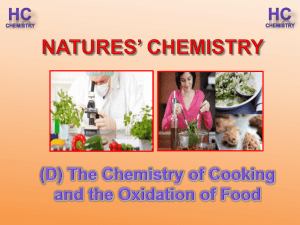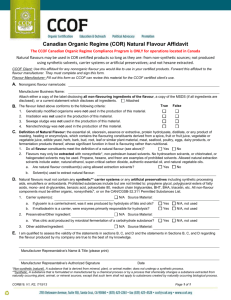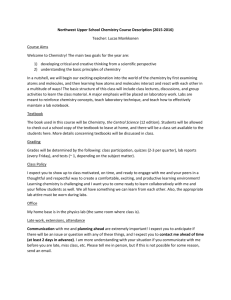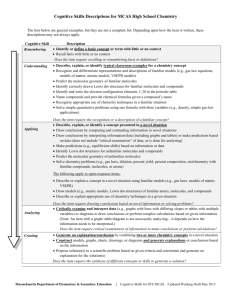SS12 - Royal Society of Chemistry
advertisement
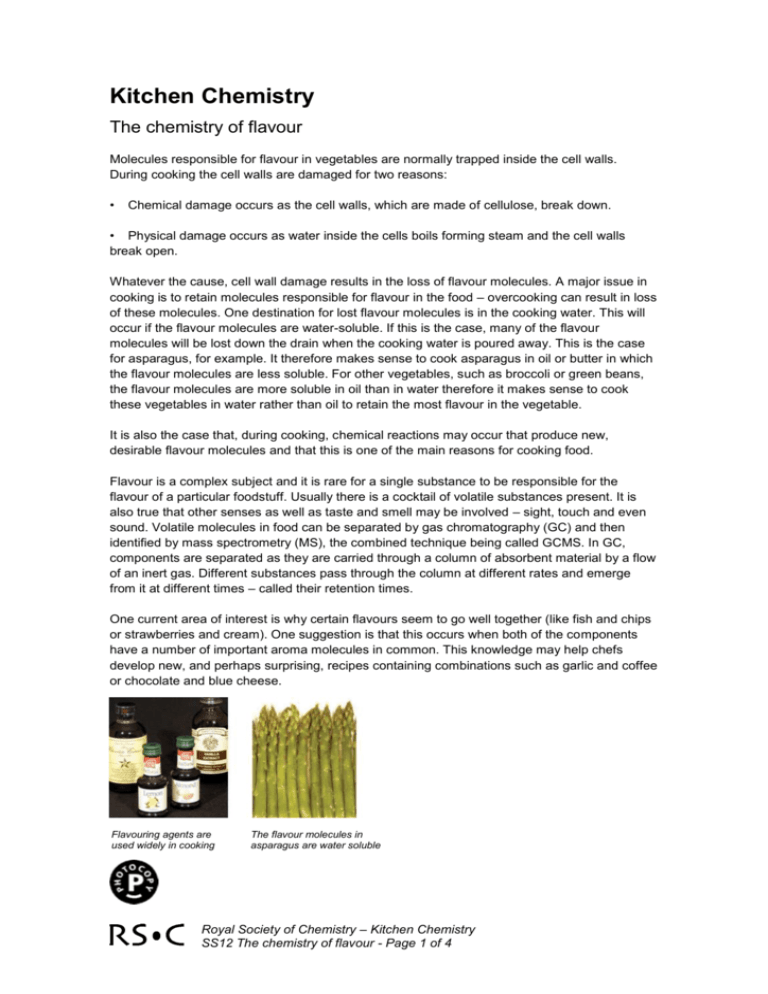
Kitchen Chemistry The chemistry of flavour Molecules responsible for flavour in vegetables are normally trapped inside the cell walls. During cooking the cell walls are damaged for two reasons: • Chemical damage occurs as the cell walls, which are made of cellulose, break down. • Physical damage occurs as water inside the cells boils forming steam and the cell walls break open. Whatever the cause, cell wall damage results in the loss of flavour molecules. A major issue in cooking is to retain molecules responsible for flavour in the food – overcooking can result in loss of these molecules. One destination for lost flavour molecules is in the cooking water. This will occur if the flavour molecules are water-soluble. If this is the case, many of the flavour molecules will be lost down the drain when the cooking water is poured away. This is the case for asparagus, for example. It therefore makes sense to cook asparagus in oil or butter in which the flavour molecules are less soluble. For other vegetables, such as broccoli or green beans, the flavour molecules are more soluble in oil than in water therefore it makes sense to cook these vegetables in water rather than oil to retain the most flavour in the vegetable. It is also the case that, during cooking, chemical reactions may occur that produce new, desirable flavour molecules and that this is one of the main reasons for cooking food. Flavour is a complex subject and it is rare for a single substance to be responsible for the flavour of a particular foodstuff. Usually there is a cocktail of volatile substances present. It is also true that other senses as well as taste and smell may be involved – sight, touch and even sound. Volatile molecules in food can be separated by gas chromatography (GC) and then identified by mass spectrometry (MS), the combined technique being called GCMS. In GC, components are separated as they are carried through a column of absorbent material by a flow of an inert gas. Different substances pass through the column at different rates and emerge from it at different times – called their retention times. One current area of interest is why certain flavours seem to go well together (like fish and chips or strawberries and cream). One suggestion is that this occurs when both of the components have a number of important aroma molecules in common. This knowledge may help chefs develop new, and perhaps surprising, recipes containing combinations such as garlic and coffee or chocolate and blue cheese. Flavouring agents are used widely in cooking The flavour molecules in asparagus are water soluble Royal Society of Chemistry – Kitchen Chemistry SS12 The chemistry of flavour - Page 1 of 4 Kitchen Chemistry Figure 1 Gas chromatogram of the volatile components from Coca Cola® Figure 2 Gas chromatogram of the volatile components from Pepsi Cola® Figures 1 and 2 show the gas chromatograms of volatile flavour components from Coca Cola® and Pepsi Cola® respectively. Each peak represents a different component. The height of each peak (strictly speaking the area underneath it) is related to the amount of that component. Two identical components would have the same retention time. Royal Society of Chemistry – Kitchen Chemistry SS12 The chemistry of flavour - Page 2 of 4 Kitchen Chemistry Questions 1. Look at the table below which shows the skeletal formulae of some flavour molecules. For each molecule, decide whether it is likely to be soluble in water or in cooking oil (a relatively non-polar solvent). Write down your answer and an explanation for each one. 2. Try to work out the systematic name of the cucumber flavour molecule. Think about the following steps: How many carbon atoms are there? What functional groups are there (and how many of each)? Where in the hydrocarbon chain are the functional groups situated? If there are any alkene functional groups, we must say if they are cis or trans. Write down your answer. Royal Society of Chemistry – Kitchen Chemistry SS12 The chemistry of flavour - Page 3 of 4 Kitchen Chemistry 3. Write the structural formula of the molecule responsible for cucumber flavour, starting CH3CH2 etc. What information is lost by writing the formula in this way rather than as a skeletal formula? 4. Flavour-causing molecules must be volatile in order to reach the nose and be detected. Explain what features of a molecule affect its volatility. What data would you look up to give an indication of how volatile a molecule is? 5. The chemical structure of part of a cellulose molecule is shown below. Identify the unit that is circled. Suggest what chemical changes might occur when a cellulose-containing food is cooked in boiling water. 6. Look at Figures 1 and 2. Do Coca Cola® and Pepsi Cola® appear to have any flavour components in common? Give the retention times of any common component(s). How do the amounts of these components compare? Royal Society of Chemistry – Kitchen Chemistry SS12 The chemistry of flavour - Page 4 of 4

